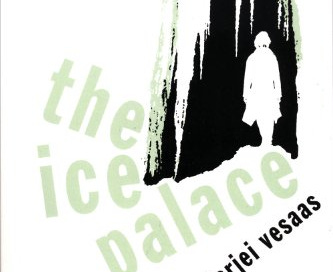I read The Ice Palace for the first time in Arnold Weinstein’s Fiction of Relationship course at Brown. My grandpa Larry was friends with Professor Weinstein and told me that I had to take the course. It didn’t disappoint. In addition to Vesaas, we read Jane Eyre, To the Lighthouse, Light in August, Beloved, Disgrace and a few other monumental novels. The Ice Palace was by far the most obscure novel on the reading list - one that few people have heard of, let alone read. Nonetheless, Weinstein contended that it deserved its place among the greatest novels ever written.
He writes about it in his book on Scandanivan literature: Northern Arts:
Critics have wrestled with terminology for Vesaas’s worldview: primitivist, romantic, pantheist, animist, and the like. All these words point toward a regime in which our customary distinctions between subject and environment, between human and nature, are dissolved, as if these convenient binaries were merely anthropocentric ways of trying to rope off phenomena, to keep the world at bay, so as to keep the human subject at the center of the picture, still in the driver’s seat. In The Ice Palace, with children protagonists and a natural setting invested with enormous power and mystery, it goes the other way: the frames no longer hold, but, instead of the crushing story we might expect (world wins, we lose), we encounter an odd and fascinating enhancement of the human drama, a magnified sense of human reach and resonance. There is great dignity in this fable of adventure, desire, death, and grieving. Our affairs are stranger and richer and larger than we had thought…At its most mythical and intense, Ice Palace explodes the fiction of a bounded self: the four-eyed face in the mirror, the unraveling in the castle of cold, the pledge of fidelity unto death, the morphing work of grieving. All in a story of two little girls.
There is much to say about this book (and Weinstein has far more to say than what he shares in the above quote). For me, the book triumphs as a beyond-chilling, sneakily provocative novel. Like a prose poem, the spartan sentences reveal far more than a first glance would suggest. The Ice Palace is a coming-of-age tale in form only; that confine exists to be remarked upon and eventually transcended, so that Vesaas’ true intentions can become markedly more pronounced.
Favorite Passages:
Four eyes full of gleams and radiance beneath their lashes, filling the looking-glass. Questions shooting out and then hiding again. I don’t know: Gleams and radiance, gleaming from you to me, from me to you, and from me to you alone—into the mirror and out again, and never an answer about what this is, never an explanation. Those pouting red lips of yours, no they’re mine, how alike! Hair done in the same way, and gleams and radiance. It’s ourselves! We can do nothing about it, it’s as if it comes from another world. The picture begins to waver, flows out to the edges, collects itself, no it doesn’t. It’s a mouth smiling. A mouth from another world. No, it isn’t a mouth, it isn’t a smile, nobody knows what it is—it’s only eyelashes open wide above gleams and radiance.
The pine needles stretch their tongues and sing an unfamiliar nocturnal song. Each tongue is so small that it cannot be heard; together the sound is so deep and powerful that it could level the hills if it wished.
They were floating, almost at one with the darkness, reflecting no light. Their footsteps could not be heard. But their breathing could, and perhaps the heart. They mingled with other almost inaudible nocturnal stirrings, like a small vibration in long wires.



![The Ice Palace (Peter Owen Modern Classics) by [Tarjei Vesaas, Elizabeth Rokkan] The Ice Palace (Peter Owen Modern Classics) by [Tarjei Vesaas, Elizabeth Rokkan]](https://substackcdn.com/image/fetch/$s_!93KQ!,w_1456,c_limit,f_auto,q_auto:good,fl_progressive:steep/https%3A%2F%2Fbucketeer-e05bbc84-baa3-437e-9518-adb32be77984.s3.amazonaws.com%2Fpublic%2Fimages%2F94b0d4a4-9509-4324-bdf9-35f2cad2f73b_333x500.jpeg)